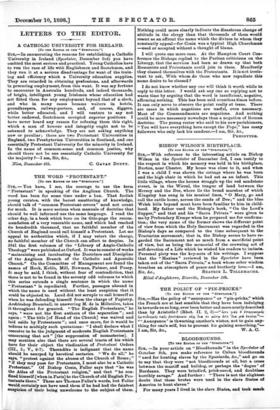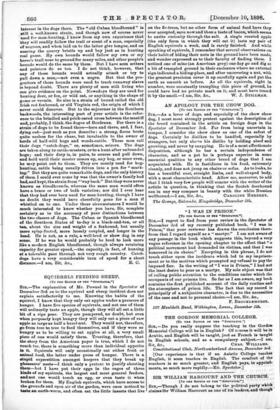BLOODHOUNDS.
[TO TEE EDITOR OF THE "SPECTATOE."]
SIR, —In your article on " Bloodhounds " in the Spectator of October 8th, you make reference to Cuban bloodhounds " used for hunting slaves by the Spaniards, &c.," and go on to say that they were "not bloodhounds at all, but a cross between the mastiff and bulldog, or perhaps the ' dogne ' of Bordeaux. They were brindled, prick-eared, and doubtless horribly savage." And further : " There is not the slightest doubt that these brutes were used in the slave States of America to hunt slaves."
For many years I lived in the slave States, and took much
interest in the dogs there. The "old Cuban bloodhound" is still a well-known strain, and though now of course never used for man-hunting, I know from my own experience that they will readily follow the trail or scent of a man, especially of negroes, and when laid on to the latter give tongue, and on nearing the quarry bristle up and bay just as in hunting real game. My own hounds would follow my own or my horse's trail nose to ground for many miles, and other people's hounds would do the same by them. But I have seen setters and pointers do so too. I do not think, however, that any of these hounds would actually attack or try to pull down a man,—not even a negro. But that the pro- genitors of these hounds were used to track runaway slaves is beyond doubt. There are plenty of men still living who can give evidence on the point. Nowadays they are used for hunting deer, or fox, or wild cat, or anything in the shape of game or vermin. So also is a strain of hound called the old Irish red foxhound, or old Virginia red, the origin of which I never could discover. But to the sojourner in the Southern backwoods, the interesting part of your article is the refer- ence to the brindled and prick-eared cross between the mastiff and, probably, I think, the dogue of Bordeaux. For there is a strain of dogs to be found there—here and there, and, I fear, dying out—just such as you describe : a strong, fierce brute quite useless for the chase, but invaluable to the owner of herds of half-wild hogs and woods-cattle. These men call their dogs " catch-dogs," or, sometimes, seizers. The dogs are taken along to cattle-musters, or to a hunt after unbranded hogs; and their duty is, in pairs, to course and pull down, and hold until their master comes up, any hog, or steer even, he may point out to them. They are mostly used for hog- hunting, cattle being usually driven into a pen for "mark- ing." But they are quite remarkable dogs, and the only history of them I could ever come by was that the owner's family had had, and kept, the strain from "'way back." But they were never known as bloodhounds, whereas the same man would often have a brace or two of both varieties; nor did I ever hear that they had ever been used for man-bunting, though I have no doubt they would have cheerfully gone for a man if whistled on to one. Under these circumstances I would be much interested to know whether you have, Sir, oomplete certainty as to the accuracy of your distinctions between the two classes of dogs. The Cuban or Spanish bloodhound of the Southern States of to-day is a black-and-tan, or all tan, about the size and weight of a foxhound, but usually more splay-footed, more loosely coupled, and longer in the head. He is not, as a rule, a well-bred or show dog in any sense. If he was he would probably be bred to look more like a modern English bloodhound, though always retaining capacity for greater speed,—the capacity, in fact, of hunting at a tolerable pace through not very rough country. Catch- dogs have a very considerable turn of speed for a short











































 Previous page
Previous page